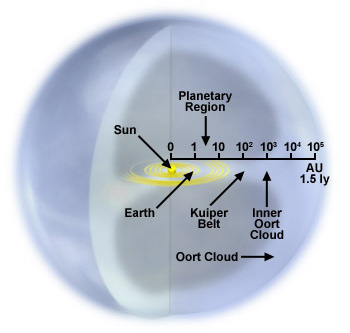Oort Cloud

Vast spherical swarm ~1012-1013 long-period comets orbiting the Solar SystemThe Sun and set of objects orbiting around it including planets and their moons and rings, asteroids, comets, and meteoroids. with semimajor axes between 1,000 and 50,000 AUThe astronomical unit for length is described as the "mean" distance (average of aphelion and perihelion distances) between the Earth and the Sun. Though most references state the value for 1 AU to be approximately 150 million kilometers, the currently accepted precise value for the AU is 149,597,870.66 km. The, typically with low orbital eccentricityThe deviation of an orbit from circularity. Circles have eccentricities of 0.. The Oort cloud, while roughly spherical at the largest radius, is wedge-shaped where it merges with the outer planetThe term "planet" originally comes from the Greek word for "wanderer" since these objects were seen to move in the sky independently from the background of fixed stars that moved together through the seasons. The IAU last defined the term planet in 2006, however the new definition has remained controversial. region in the vicinity of the Kuiper beltRegion in the outer solar system beyond Neptune's orbit that contains billions of small, icy planetesimals from the original protoplanetary disc that failed to coalesce into planets. The Kuiper Belt extends from Neptune's orbit at 30 AU to ~55 AU. It is ~20x wider and 20-200x more massive than the of comets. The cloud is divided into different regions of dynamical stability: the Kuiper Belt (35-50 AU; affected by planetary perturbations), a dynamically inert region (50-2000 AU; not affected by gravityAttractive force between all matter - one of the four fundamental forces. of planets or stars), the inner Oort cloud (2,000-15,000 AU; affected by galactic tidal forces), and the outer Oort cloud (15,000-100,000 AU; affected by stellar perturbations). The Oort cloud has never been observed rather its existence is inferred from analysis of the orbits of comets, which come in from the cloud. Recent discoveries of Kuiper Belt objectsGenerally, small bodies found in the Kuiper Belt. The largest Kuiper Belt Object (KBO), Eris, is <3000 km in diameter. Image source: http://en.wikipedia.org/wiki/File:EightTNOs.png have confirmed its existence.
Some or all content above used with permission from J. H. Wittke.






